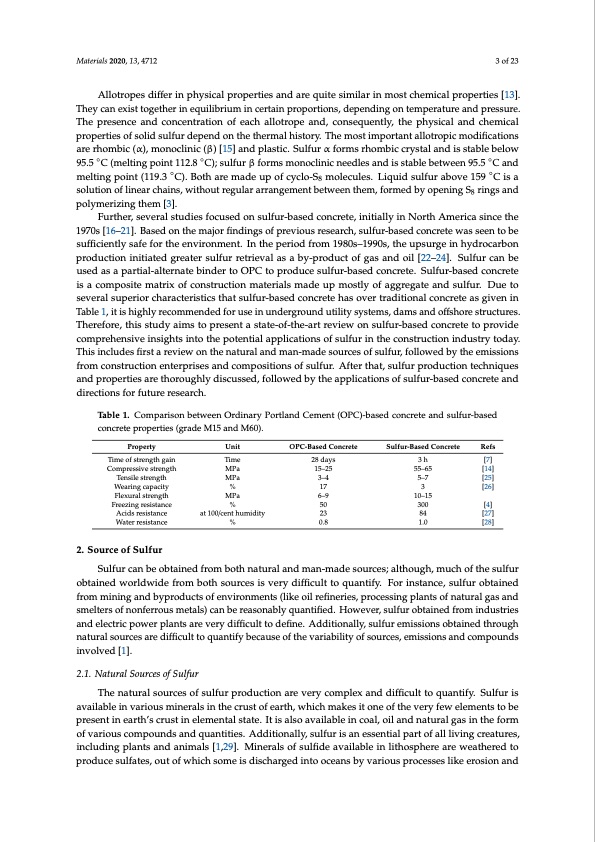
PDF Publication Title:
Text from PDF Page: 003
Materials 2020, 13, 4712 3 of 23 Allotropes differ in physical properties and are quite similar in most chemical properties [13]. They can exist together in equilibrium in certain proportions, depending on temperature and pressure. The presence and concentration of each allotrope and, consequently, the physical and chemical properties of solid sulfur depend on the thermal history. The most important allotropic modifications are rhombic (α), monoclinic (β) [15] and plastic. Sulfur α forms rhombic crystal and is stable below 95.5 ◦C (melting point 112.8 ◦C); sulfur β forms monoclinic needles and is stable between 95.5 ◦C and melting point (119.3 ◦C). Both are made up of cyclo-S8 molecules. Liquid sulfur above 159 ◦C is a solution of linear chains, without regular arrangement between them, formed by opening S8 rings and polymerizing them [3]. Further, several studies focused on sulfur-based concrete, initially in North America since the 1970s [16–21]. Based on the major findings of previous research, sulfur-based concrete was seen to be sufficiently safe for the environment. In the period from 1980s–1990s, the upsurge in hydrocarbon production initiated greater sulfur retrieval as a by-product of gas and oil [22–24]. Sulfur can be used as a partial-alternate binder to OPC to produce sulfur-based concrete. Sulfur-based concrete is a composite matrix of construction materials made up mostly of aggregate and sulfur. Due to several superior characteristics that sulfur-based concrete has over traditional concrete as given in Table 1, it is highly recommended for use in underground utility systems, dams and offshore structures. Therefore, this study aims to present a state-of-the-art review on sulfur-based concrete to provide comprehensive insights into the potential applications of sulfur in the construction industry today. This includes first a review on the natural and man-made sources of sulfur, followed by the emissions from construction enterprises and compositions of sulfur. After that, sulfur production techniques and properties are thoroughly discussed, followed by the applications of sulfur-based concrete and directions for future research. Table 1. Comparison between Ordinary Portland Cement (OPC)-based concrete and sulfur-based concrete properties (grade M15 and M60). Property Time of strength gain Compressive strength Tensile strength Wearing capacity Flexural strength Freezing resistance Acids resistance Water resistance 2. Source of Sulfur Unit Time MPa MPa % MPa % at 100/cent humidity % OPC-Based Concrete 28 days 15–25 3–4 17 6–9 50 23 0.8 Sulfur-Based Concrete Refs 3 h [7] 55–65 [14] 5–7 [25] 3 [26] 10–15 300 [4] 84 [27] 1.0 [28] Sulfur can be obtained from both natural and man-made sources; although, much of the sulfur obtained worldwide from both sources is very difficult to quantify. For instance, sulfur obtained from mining and byproducts of environments (like oil refineries, processing plants of natural gas and smelters of nonferrous metals) can be reasonably quantified. However, sulfur obtained from industries and electric power plants are very difficult to define. Additionally, sulfur emissions obtained through natural sources are difficult to quantify because of the variability of sources, emissions and compounds involved [1]. 2.1. Natural Sources of Sulfur The natural sources of sulfur production are very complex and difficult to quantify. Sulfur is available in various minerals in the crust of earth, which makes it one of the very few elements to be present in earth’s crust in elemental state. It is also available in coal, oil and natural gas in the form of various compounds and quantities. Additionally, sulfur is an essential part of all living creatures, including plants and animals [1,29]. Minerals of sulfide available in lithosphere are weathered to produce sulfates, out of which some is discharged into oceans by various processes like erosion andPDF Image | Critical Review on the Properties and Applications of Sulfur-Based Concrete

PDF Search Title:
Critical Review on the Properties and Applications of Sulfur-Based ConcreteOriginal File Name Searched:
materials-13-04712.pdfDIY PDF Search: Google It | Yahoo | Bing
Sulfur Deposition on Carbon Nanofibers using Supercritical CO2 Sulfur Deposition on Carbon Nanofibers using Supercritical CO2. Gamma sulfur also known as mother of pearl sulfur and nacreous sulfur... More Info
CO2 Organic Rankine Cycle Experimenter Platform The supercritical CO2 phase change system is both a heat pump and organic rankine cycle which can be used for those purposes and as a supercritical extractor for advanced subcritical and supercritical extraction technology. Uses include producing nanoparticles, precious metal CO2 extraction, lithium battery recycling, and other applications... More Info
| CONTACT TEL: 608-238-6001 Email: greg@infinityturbine.com | RSS | AMP |